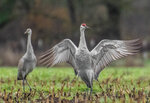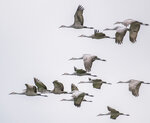




Jay Gordon’s farm between Porter and Elma has been in his family since the late 1700s. In 1872, Ulysses S. Grant signed a deed for the homestead.
In 2023, Gordon is one of just three farmers in his stretch of the Chehalis River Valley who farms corn. Unlike the others, though, two of Gordon’s fields still have upright stalks with ears of corn on Nov. 22. He’s saving them for a very unique set of customers: about 56 sandhill cranes and 140 trumpeter swans.
Next week, check out “Beak of the Week” to learn more about the swans.
Taller and much more plump than a great blue heron, the greater sandhill crane’s call can be heard up to 4 miles away. Gordon first recorded about 17 birds on his farm in the winter of 2021, and about 40 the following winter.
Every year, they bring more. Nearly as tall as the corn stalks that attract them, the sandhills dance and jump as cranes do in traditional Japanese paintings.
According to the Madison, Wisconsin Audubon Society, sandhills dance for three main reasons: to attract a mate, to strengthen bonds with a partner or to display aggression.
The birds can also be found in the Ridgefield National Wildlife Refuge. In the summer of 2020, two adult pairs were seen nesting at the refuge — the first documented summer sandhill sighting in Western Washington in over 100 years, according to the Department of Fish and Wildlife.
With a few exceptions, the cranes mate for life. The young learn migration patterns from their parents, according to Fish and Wildlife, so it’s likely the cranes on Gordon’s property will be around for many winters to come.
Besides corn, the dinosaur-like birds enjoy frogs, mice, seeds, wheat and berries. Prone to near-constant bogginess due to rain, significant tides and floods, the Chehalis River Valley around Porter offers plenty of frogs.
“I’m not the only one in the valley with frogs,” Gordon said with a chuckle when noting that the cranes fly between different fields throughout the day.
The birds are capable of flying 400 miles in a day.
As if they weren’t likable enough, the cranes are also equitable: Both mates gather material to build nests, which are typically on the ground, and both sit on the nest at times. There has also never been a recorded instance of the sandhill crane dads complaining about household chores.
Learn more about the cranes at https://www.allaboutbirds.org/guide/Sandhill_Crane/lifehistory#.